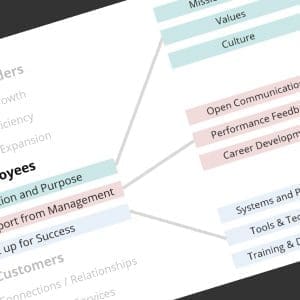To be successful in leading change and creating value, demonstrate your ability to make Change happen skills in People, Process, or Technology.
If you want to be successful in leading change and creating value (revenue growth (top line) or earnings growth (bottom line) ), you’ll have to find a link between your ideas and the current state of things. Your ability to demonstrate the connection between your skills & experience, the current state of “how things work”, and the growth and improvement that Change represents, is a key to success.
A common way of expressing “how things work” is to talk about “People, Process, and Technology”. I’m not sure who came up with this little gem, or in what context, but I’ve been hearing hearing it a lot lately; no particular reason, just that it seems to be gaining a bit of status as a second-tier buzzword or something. I’ve noticed, however, that people seem very comfortable talking about People, Process, and Technology in the As-Is or To-Be states – with precious little time spent on the difficulties in getting Change to happen in any of these areas. Project teams and project leaders need to be effective at making Change happen with People, Process, and Technology; maintaining the status quo is comfortable, and envisioning the “nirvana” Future State is easy, but the real challenge comes in making the transition from A to B.
Transformative initiatives need leaders that have Change skills:
- People Change – Soft skills and Emotional Intelligence are typically required, but effective team leaders need to be able to command a room of strong personalities and competing agendas. Some meeting facilitators are direct, and can shout folks down and/or eloquently shift the group’s understanding. Others work indirectly, creating understanding and acceptance in non-threatening, semi-private conversations.
- Process Change – It’s easy to say “automate a mess, and you get an automated mess”, but the challenges of process redesign are known to many folks. A certain amount of patience and insight is required to ferret out muda (waste) in the process, to understand and identify the critical elements / tasks, and to aggressively involve the eventual process owners, cementing their commitment for implementation by making them part of the design.
- Technology Change – Typically the easiest (and preferred) work area for many folks (bright shiny things!) but for those who want to make a real difference, you need the ability to understand and implement new technologies quickly, in a sustainable and supportable fashion. Points are taken off for quickly implementing a fragile system.
WIIFM?
Looking for ways to create concrete objectives for yourself or your teams? The significant Value Add that projects and project teams bring to organizations covers all three areas – People Change, Process Change, and Technology Change. Improvement and effectiveness doesn’t come from raw skills in People, Process, or Technology, but a demonstrated ability to make Change happen in any and all of these three areas.
The opportunity, of course, is to pick one or two of these areas, and build your skills in making Change happen. If you aren’t good in front of a group of people, and are more comfortable working directly with the technology, work on your Change skills by understanding new developments and methods, and figuring out how to use that stuff to make projects and processes happen faster, with higher quality and more predictable outcomes. Looking for a stretch? Get into Process design and development; it’s not always about the bits and bytes, but systems thinking is a big plus, and Process skills are often a great way to bridge from Technology to People skills.
14 February, 2010






Comments (1)
Thanks for the link and good post on the topic, particularly the key of getting people to embrace change – often the greatest hurdle.
Best regards
Justin